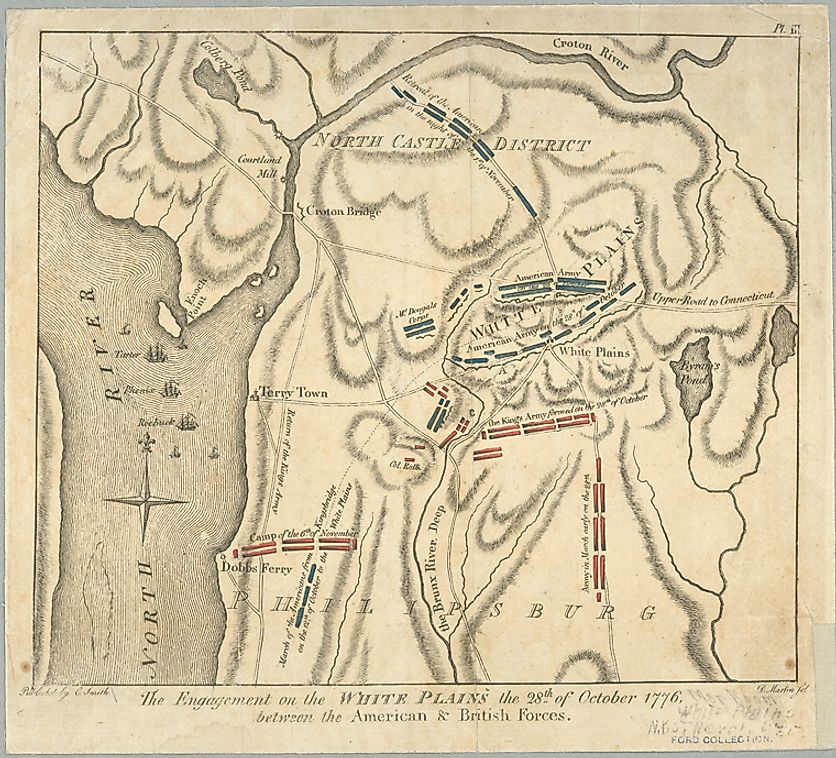The Battle of White Plains: The American Revolutionary War

5. Background
The Battle of White Plains was fought on October 28th, 1776. It was an integral battle of the American Revolutionary War in the New York and New Jersey campaigns. It is considered to be among the most important battles in American military history. The Battle of White Plains occurred in the wake of the defeat the American Colonials suffered at the battle of Long Island in August of 1776. Subsequent to that loss, George Washington and his army were forced to watch and wait for British General Howe and his army’s next move, in order to best prepare to make their own. The Continental troops were spread out over the island of Manhattan and across the Hudson River on the New Jersey mainland. On the 12th of October General Howe, with 90 supporting boats and 4,000 troops, moved up the East River to Throg’s Neck. His troops disembarked there, in order to establish a fortified line along the Hudson River, circling around the American army and preventing them from finding an escape route. Such a position would allow Howe to easily transport his manpower, the most professional army of its time, to strike at any point along Manhattan and New Jersey's shoreline of his choosing. However, the British inland path was blocked by troops and swamps. Howe and his troops were forced to return to their boats, and traveled 3 miles north to Pell's Point. There, on October 18th the British troops disembarked again with the same aim of assuming a chokehold position.
4. Makeup
William Howe led a combined force of British and contracted Hessian professional soldiers with naval support along the waterways, aided by native Loyalists. The Joint Command of George Washington and Major Generals Joseph Spencer and Alexander led an outmanned group of volunteer Continental Army troops. Some estimates place the British and their supports’ total size in the battle as being as high as 7,500, in comparison to the Continentals’ little more than 3,000 men. Both sides utilized straight muskets among regular infantry, rifles among the most skilled riflemen, and lesser quantities of supporting caisson guns.
3. Description
Both sides bided time and organized their respective strategies, as military and civilian leaders alike speculated about the cause of the fire that consumed New York City on September 21st, which Howe accused Washington of starting in an act of arson against his occupying British. As Washington spoke of his woes in New York to the Continental Congress, William Howe lurched back into action on October 12th. While he hoped to avoid a costly assault against the American army, whose troops were entrenched among the northern Manhattan hills, his prospects of gaining ground on and encircling the Continentals without massive losses actually proved impractical. Instead, he ultimately sent his soldiers by boat to positions along the banks of the East River. Inland were about 750 infantrymen under the command of John Glover, who gathered his troops behind some stone walls and then attacked the British army. As the British took their places, the American army fell back, in order to reorganize. After some minor attacks, the British broke off and the American army retreated. This battle delayed the movements of the British to give time for Washington to move further with his army to a position about 18 miles away at White Plains, while avoiding being surrounded by the enemy. On the 22nd of October, Washington made a defensive line in White Plains. General Howe and his troops finally made it to White Plains on the 28th of October, with the aim of attacking a strategic hill the Continentals held outside of the town, because he understood how important it was. Washington failed to hold them off in defense of Charleton Hill, and the army of the British won the battle, with more than 200 Americans being either killed, wounded, missing, or captured.
2. Outcome
Even though both sides remained at their positions for two more days, General Howe made a plan to attack again the American army the next day, but couldn't do so because of the heavy rain. Washington had the chance to protect his army by establishing a camp to the North. On November 1, Howe found out that Washington had actually eluded his grasp. The British troops went back to Manhattan. On the 5th of November, Howe turned his troops to South, in order to finish evicting the army troops of his enemy from Manhattan. The battle itself resulted in 47 killed, 182 wounded, and 4 missing among the British forces, and 50 deaths, 150 wounded, and 17 captured or missing within the Continental Army.
1. Significance
Eventually, Washington managed to cross the Hudson River with most of his army, leaving behind him New England regiments in order to guard the supply stores. Later, the British caught him across New Jersey and Pennsylvania state. Washington saw the opportunity to win the battle and boost the morale of his nation and crossed the Delaware and surprised Rall's troops in the resulting Battle of Trenton. This was but one in a long line of tactical retreats that Washington used to continually improve his position, and eventually win the war. Some assert that the “Headless Horsemen” of Washington Irving’s Sleepy Hollow tale was inspired by a Hessian soldier in service to the British that lost his head in the Battle of White Plains. Two US Navy ships, a Casablanca-class escort carrier launched during World War II and a Mars-class combat stores ship launched prior to the Vietnam War, were named USS White Plains in honor of the battle. Every year, the town of White Plains holds commemorative events in celebration of the battle as well.







